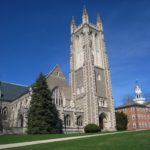What Are the Southern Ivies? Is there a Southern Ivy League?
What’s Covered:
- Does the Southern Ivy League Exist?
- What Are Some Potential “Southern Ivies”?
- What Are Your Chances of Acceptance?
The Ivy League is a term commonly used for some of the most prestigious institutions in the U.S. All the Ivies are located in the northeastern part of the country; this is because the Ivy League was originally formed as an athletic league that made it easy for eight of the oldest schools in the U.S. to play sports against one another.
So, is there a Southern Ivy League then? If so, which schools are considered Southern Ivies? Read on to find out.
Does the Southern Ivy League Exist?
While there is no one-to-one comparison for the Ivy League in the southern U.S., the South is home to a handful of institutions that rival their northern counterparts in prestige, academic excellence, and challenging admissions. Some of the schools commonly considered “Southern Ivies” are actually known as “Public Ivies”—a term coined by Richard Moll in 1985 in his book, Public Ivies: A Guide to America’s Best Public Undergraduate Colleges and Universities, to describe a collection of schools that offer an outstanding educational experience at a fraction of the price of the actual Ivy League.
What Are Some Potential “Southern Ivies”?
There is no official list of Southern Ivy League schools, but below you’ll find 15 of the South’s finest institutions. These schools offer the academics, opportunities, challenges, and history of the original eight Ivies—some even predate them—while also offering a slice of southern hospitality and eliminating the harsh winters of the Northeast.
|
School |
State |
Undergraduate Enrollment |
Acceptance Rate |
|
NC |
6,800 |
6% |
|
|
TX |
4,200 |
9% |
|
|
TN |
7,100 |
7% |
|
|
VA |
1,800 |
19% |
|
|
GA |
7,100 |
13% |
|
|
NC |
1,900 |
18% |
|
|
NC |
19,800 |
20% |
|
|
NC |
5,400 |
25% |
|
|
VA |
17,200 |
21% |
|
|
LA |
8,700 |
10% |
|
|
VA |
3,100 |
29% |
|
|
VA |
6,500 |
37% |
|
|
FL |
34,800 |
30% |
|
|
GA |
17,400 |
16% |
|
|
TX |
40,900 |
29% |
1. Duke University
Location: Durham, NC
CollegeVine ranking: 6
Acceptance rate: 6%
Undergraduate enrollment: 6,800
Duke’s roots trace back to 1838 as a subscription school for the Methodist and Quaker families in rural Randolph Country. Over the past 180+ years, the university has evolved quite a bit. Today, Duke is a leader in liberal arts education. A Duke education instills “habits of mind” in their students to help develop skills such as critical thinking and creative problem solving, and to foster an appetite for discovery that helps students succeed at Duke and in life.
A core value at Duke is undergraduate research (research opportunities are offered to students in all majors). This provides students with an excellent opportunity to gain experience and helps bolster the resume of those hoping for a job within the research triangle—the name given to the hyper-educated area encompassing three North Carolina cities (Raleigh, Durham, and Chapel Hill).
2. Rice University
Location: Houston, TX
CollegeVine ranking: 16
Acceptance rate: 9%
Undergraduate enrollment: 4,200
Rice’s combination of being a mid-size school in a big city (Houston is the nation’s fourth-largest city) allows students to enjoy the familiarity of a smaller community on campus, but also experience bigger city life. Rice’s campus is tight-knit; there are no fraternities or sororities, and the university’s residential system randomly assigns students to one of its 11 colleges—where they maintain membership through their undergraduate years, which creates a family-like atmosphere.
Rice is located minutes away from Houston’s downtown and in the heart of its museum district. Despite Houston’s size, the city itself can feel suburban—it’s much more spread out than cities like New York, Chicago, and Boston.
3. Vanderbilt University
Location: Nashville, TN
CollegeVine ranking: 18
Acceptance rate: 7%
Undergraduate enrollment: 7,100
There’s a lot to love about Vanderbilt, including top-notch academics, a world-class city, and its gorgeous campus. In the classroom, Vanderbilt students rave about the low teacher-to-student ratio (8:1) and flexibility on the academic path (if you don’t like your major, you can easily change it). Another quality to love about Vanderbilt is that it’s a no-loan school, which means the university will meet 100% of every student’s demonstrated financial need without loans.
The city of Nashville provides students with nearly unlimited entertainment opportunities (it’s the Music City, after all) and restaurants galore. Of course, it’s tough to pry yourself away from Vanderbilt’s stunning campus—it’s a National Arboretum containing about 170 species of trees and shrubs.
4. Washington and Lee University
Location: Lexington, VA
CollegeVine ranking: 33
Acceptance rate: 19%
Undergraduate enrollment: 1,800
Washington and Lee University earns high marks from more than just CollegeVine. The website Niche ranks it as both the 10th best small college and the 10th best liberal arts college in America. Washington and Lee University makes a no-loan commitment to its students; that is, the university will meet 100% of demonstrated need with federal, institutional, and state grants along with student employment—none of which requires repayment.
Washington and Lee follows a unique three-term academic calendar that consists of two 13-week terms followed by an immersive 4-week spring term. This gives students the chance to have a transformative learning experience, such as studying the science of cooking in Italy or learning about geology while rafting in the Grand Canyon.
5. Emory University
Location: Atlanta, GA
CollegeVine ranking: 36
Acceptance rate: 13%
Undergraduate enrollment: 7,100
Emory’s gorgeous main campus is located in Atlanta, the capital of Georgia. A progressive, vibrant, and global city (it hosted the Olympics in 1996), Atlanta offers a multitude of entertainment, shopping, and culinary distractions from the classroom—including the largest aquarium in the world, housing more than 100,000 sea creatures. Atlanta is also home to 700 Fortune 1000 companies, an enticing prospect for students looking for internships or careers after graduation.
Emory’s main campus provides everything a student needs to succeed, from small class sizes (71% have fewer than 20 students) to an extensive (150,000+ person) worldwide alumni network. Undergraduates studying liberal arts at Emory also have the option of spending their first two years at the university’s Oxford, Georgia, campus, which provides a small-town, close-knit setting just 36 miles from downtown Atlanta.
6. Davidson College
Location: Davidson, NC
CollegeVine ranking: 41
Acceptance rate: 18%
Undergraduate enrollment: 1,900
Davidson’s honor code differentiates it from other colleges and universities. More than just words, the honor code encapsulates the Davidson experience—which includes take-home tests and self-proctored final exams. Beyond the classroom, the honor code means if you lose your wallet on Davidon’s campus, there’s a good chance there will be an announcement to reunite it with you.
The honor code helps form a close bond between students, faculty, and staff. That bond is only strengthened by the school’s small class sizes (17 students on average). Need another reason to love Davidson? The college was the first liberal arts school to eliminate loans in financial aid packages. The Davidson Trust meets 100% of the calculated financial need of accepted students through a combination of grants and campus employment.
7. University of North Carolina at Chapel Hill | UNC
Location: Chapel Hill, NC
CollegeVine ranking: 43
Acceptance rate: 22%
Undergraduate enrollment: 19,800
UNC is known for its academics, post-graduation employment opportunities, and athletics. UNC is one of the 15 schools commonly grouped together and called “Public Ivies” and is located in the research triangle—together with cross-town rival Duke—which is home to more than 300 companies.
UNC has a reputation for exceptional athletics; the Tar Heels have won 49 NCAA team championship titles, including six titles for the men’s basketball team and a staggering 21 titles for the women’s soccer team.
Offering a great education for more than two centuries, UNC was the first public university in the U.S. and the only one to graduate students in the eighteenth century. It admitted its first class in 1795.
8. Wake Forest University
Location: Winston-Salem, NC
CollegeVine ranking: 44
Acceptance rate: 25%
Undergraduate enrollment: 5,400
Wake Forest has long been on the cutting edge—it was the first top 30 national university to do away with standardized test requirements in the undergraduate admissions process; it also recently opened Wake Downtown, its 151,000-square-foot hub of programming dedicated to engineering and biomedical sciences.
Wake Forest maintains a close-knit, welcoming, and friendly campus. For example, 1,360 undergraduates participated in 2022’s Wake ‘N Shake—the school’s annual 12-hour dance marathon benefiting cancer research—raising more than $310,000.
Wake Forest undergraduates are required to live on campus for their first six semesters. However, about three-quarters of its undergraduate population live on campus.
9. University of Virginia | UVA
Location: Charlottesville, VA
CollegeVine ranking: 49
Acceptance rate: 21%
Undergraduate enrollment: 17,200
Founded in 1819 by Thomas Jefferson, UVA has a 200-year tradition of attracting intellectually curious students from not only Virginia, but from across the U.S. and the globe. In fact, Jefferson considered the founding of the university as one of his greatest achievements—he recruited the faculty, planned the curriculum, and designed the iconic Rotunda.
Charlottesville is an idyllic college town, big enough to provide an interesting diversion from your studies, but not so big as to be a distraction. A unique attribute of UVA is that there are no “freshmen” or “seniors” on campus; rather, students are called first-years through fourth-years because Jefferson believed no one could be a senior in their education. In fact, the campus isn’t even called a campus, it’s called the “grounds.”
10. Tulane University
Location: New Orleans, LA
CollegeVine ranking: 53
Acceptance rate: 10%
Undergraduate enrollment: 8,700
Tulane’s New Orleans location offers students the opportunity to experience one of the most culturally vibrant cities in the nation. From festivals to music to cuisine, it provides students with numerous opportunities outside of the classroom. It may also contribute to Tulane’s reputation as a party school—the website Niche ranks it as the second-best party school in America.
Tulane has also forged a reputation for research, it’s ranked by the Carnegie Foundation as a university with “very high research activity.” A unique aspect of a Tulane education is that community service is central to its core curriculum—it’s required for graduation.
11. University of Richmond
Location: Richmond, VA
CollegeVine ranking: 57
Acceptance rate: 29%
Undergraduate enrollment: 3,100
Students from across the nation and globe are attracted to the University of Richmond’s campus—47 states and 62 countries are represented by undergraduates. Part of the appeal is the university’s small classes (the average undergraduate class size is 16) and low student-to-faculty ratio (8:1).
Another appealing quality of the university is its “Richmond Guarantee.” That is, every undergraduate student is eligible to receive a fellowship of up to $5,000 for an unpaid or underpaid summer internship or faculty-mentored research project. In 2022, the University of Richmond awarded $2 million while supporting 490 fellowships in 24 states and 22 countries.
12. College of William & Mary | William & Mary
Location: Williamsburg, VA
CollegeVine ranking: 64
Acceptance rate: 37%
Undergraduate enrollment: 6,500
Many describe the College of William and Mary as an “Ivy League-quality education at state-school prices.” The college has the distinction of being the second-oldest college in the U.S.; it was founded in 1693 and only Harvard is older. History is palpable at the school, which is adjacent to Colonial Williamsburg—a restored colonial area.
The College of William and Mary is a small school, set in a small town, and students are prohibited from owning a car, which leads to a familiar, tight-knit, and campus. More than 450 clubs and organizations are found on campus and staying busy at the college is part of its culture.
13. University of Florida
Location: Gainesville, FL
CollegeVine ranking: 67
Acceptance rate: 30%
Undergraduate enrollment: 34,800
This university is big—it’s home to one of the largest student bodies in the nation, spans over 2,000 acres, and includes more than 900 buildings. Its football stadium can hold an incredible 88,548 fans! That’s not all that’s large at the university—in 2022 it surpassed $1 billion in research funding.
University of Florida alumni are extremely accomplished, particularly in athletics. Notable alumni include three Heisman Trophy winners (Steve Spurrier, Danny Wuerffel, and Tim Tebow), NFL Hall of Famer Emmitt Smith, and ex-NBA All-Star Joakim Noah. Alumni do equally well off the field; 10 Florida governors attended the university.
14. Georgia Institute of Technology | Georgia Tech
Location: Atlanta, GA
CollegeVine ranking: 68
Acceptance rate: 16%
Undergraduate enrollment: 17,400
Georgia Tech is one of the best public institutions in the U.S. and is well known for its excellent engineering and computer science programs. The school opened its doors in 1884 as an all-male trade school; women weren’t admitted until 1952. In 1961, Georgia Tech became the first university in the Deep South to admit African-American students without a court order.
Georgia Tech’s campus is home to a variety of interesting historical sites. For example, the surrender of Atlanta during the Civil War and the school’s Bobby Dodd Stadium at Historic Grant Field is the oldest on-campus stadium in NCAA Division I-A. Another interesting fact about Georgia Tech’s campus is that it was the site of the Olympic athlete village during the 1996 Summer Olympics.
15. University of Texas at Austin | UT Austin
Location: Austin, TX
CollegeVine ranking: 68
Acceptance rate: 29%
Undergraduate enrollment: 40,900
UT Austin lives up to the saying everything is bigger in Texas—with more than 40,000 undergraduates, the school is one of biggest colleges in the country. UT Austin offers more than 170 undergraduate fields of study, 12,000 courses, and 400 study-abroad programs. It’s no wonder the university attracts students from all 50 states and 130+ countries.
On campus, students are provided with an enormous amount of resources. UT Austin is home to 17 libraries containing more than 10 million volumes. When students can break away from their studies, they’ll find over 1,000 student organizations catering to all manner of interests and hobbies.
What Are Your Chances of Acceptance?
Like their counterparts in the Northeast, the Southern Ivies are extremely selective. That said, your odds of admission into one of these stellar schools depend on the strength of your profile. CollegeVine can help you better understand your chances of acceptance. Our free chancing engine uses data points like grades, test scores, and extracurricular activities to estimate your odds of getting into the Southern Ivies along with hundreds of other colleges across the country—helping you build an informed college list and see how you stack up against other applicants.


